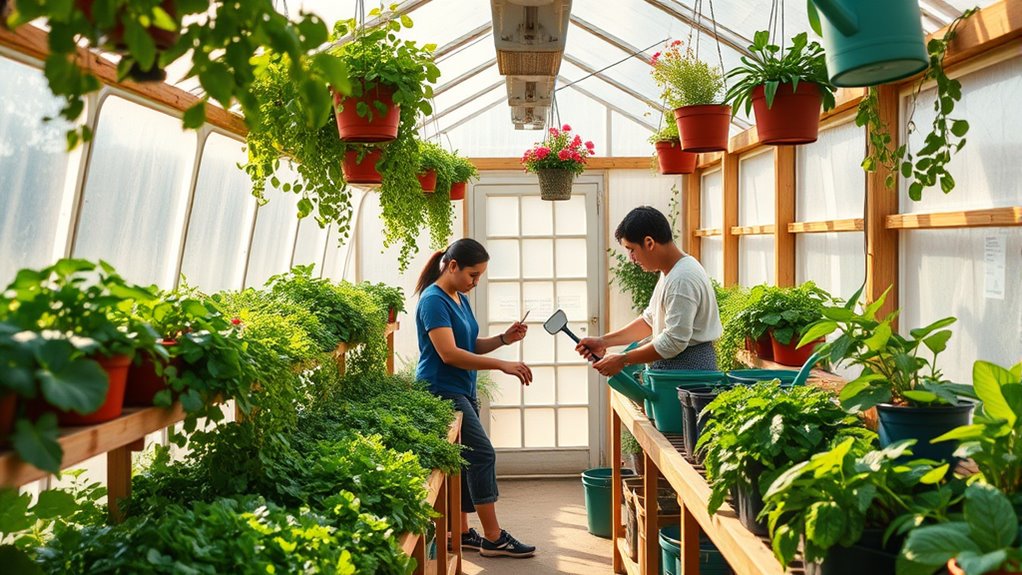Neighborhood greenhouse co-ops let you share land, tools, and expertise with neighbors, making urban farming both affordable and sustainable. By pooling resources, you can access better equipment, expand your gardening space, and learn new skills together. This collective approach reduces costs and fosters community bonds, helping everyone grow fresh produce locally. If you want to discover how these co-ops boost food security and strengthen neighborhoods, explore more about their benefits and how to get involved.
Key Takeaways
- Co-ops enable neighbors to share land, tools, and expertise, reducing individual costs and increasing gardening accessibility.
- Pooling resources allows collective investment in greenhouse infrastructure and gardening supplies.
- Sharing knowledge through workshops and demonstrations fosters skill development and sustainable practices.
- Resource sharing strengthens community bonds and encourages teamwork in urban farming efforts.
- Collaborative resource management enhances local food security and resilience in neighborhoods.

Neighborhood greenhouse co-ops are transforming how communities access fresh, locally grown produce. When you get involved, you’re not just planting seeds; you’re becoming part of a movement that promotes urban farming and community education. These co-ops make it easier for you to grow your own food without needing a large backyard or expensive equipment. Instead, you share resources like land, tools, and expertise with neighbors who share your passion for fresh, healthy food. By pooling resources, you reduce costs and increase access to gardening materials, making urban farming more practical and affordable for everyone involved.
Neighborhood greenhouse co-ops make urban farming affordable and accessible through shared resources and community collaboration.
As you participate in a neighborhood greenhouse co-op, you discover the benefits of urban farming firsthand. It’s a way to turn small plots of urban land into productive gardens, providing fresh produce right in the heart of the city. This approach helps cut down on food miles, ensuring that what you eat is fresher and more nutritious. Plus, urban farming in a co-op setting fosters a sense of community, encouraging neighbors to work together, share tips, and learn from each other’s experiences. You might find yourself exchanging ideas about composting, pest control, or seasonal planting, all of which deepen your understanding of sustainable practices. Engaging with sustainable practices in urban farming enhances your skills and promotes environmental stewardship.
Community education is a key element of these co-ops. As you participate, you gain practical skills and knowledge about gardening, soil health, and sustainable food systems. Many co-ops host workshops, classes, and hands-on demonstrations that are open to everyone, regardless of experience level. This environment allows you to learn from others, share your own insights, and build confidence in your ability to grow food. You’re encouraged to experiment with different crops, understand what grows best in your local climate, and develop a greater appreciation for the complexity of food production. This ongoing education helps you make better choices about what you eat and how you grow it.
Sharing resources in a neighborhood greenhouse co-op also means you’re helping to foster resilience and self-sufficiency within your community. When everyone contributes—whether it’s seeds, soil, or labor—you reduce dependency on commercial food sources and strengthen local food security. You become part of a network that values sustainability, teamwork, and education. This collective effort not only produces tangible benefits like fresh vegetables but also builds social bonds, trust, and a sense of pride in creating a healthier, greener neighborhood. Ultimately, participating in a greenhouse co-op empowers you to take control of your food and learn new skills, all while making a positive impact on your community’s environment and well-being.
Frequently Asked Questions
How Do Co-Ops Handle Financial Contributions and Cost Sharing?
You contribute through membership fees, which help cover shared expenses. The co-op handles cost sharing by dividing costs fairly among members based on usage, participation, or a set fee structure. You’ll often see transparent budget reports, so you know exactly how your contributions are allocated. This system encourages fairness and community involvement, making sure everyone shares responsibilities and benefits equally, fostering a cooperative environment.
What Are the Best Practices for Managing Shared Greenhouse Spaces?
Ever wonder how shared greenhouse spaces stay productive and harmonious? You should prioritize clear communication and establish guidelines for community engagement and resource allocation. Regular meetings help address concerns and keep everyone involved. Assign roles for maintenance and decision-making, and keep a shared calendar for planting and harvesting schedules. By fostering transparency and collaboration, you create a thriving environment where everyone benefits and feels invested in the co-op’s success.
How Do Co-Ops Resolve Conflicts Among Members?
When conflicts arise, you should prioritize clear member communication and conflict resolution strategies. Encourage open discussions, listen actively to all sides, and establish fair, consistent procedures for resolving disagreements. Mediation can help facilitate understanding, while setting shared guidelines guarantees everyone knows expectations. By fostering a respectful environment and addressing issues promptly, you create a cooperative atmosphere where members feel valued and conflicts are effectively managed, keeping the co-op functioning smoothly.
What Legal Considerations Exist for Forming a Greenhouse Co-Op?
When forming a greenhouse co-op, you need to consider liability agreements to protect members from potential legal issues. Make sure to establish clear membership eligibility criteria to ensure only qualified individuals join. You should also register your co-op according to local laws, draft bylaws, and consider tax implications. Consulting with a legal professional helps you navigate these considerations, ensuring your co-op operates smoothly and legally from the start.
How Can Neighborhoods Attract More Participants to Co-Op Initiatives?
You might think it’s hard to attract more participants, but ironically, hosting vibrant social events and engaging in community outreach can work wonders. When neighbors see the fun and benefits firsthand, they’re more likely to join. Use these activities to build relationships, share successes, and showcase your co-op’s positive impact. This genuine engagement turns curiosity into commitment, making your greenhouse co-op a thriving hub of shared growth and sustainability.
Conclusion
Joining a neighborhood greenhouse co-op is like planting a seed of community and sustainability. You share resources, knowledge, and support, making gardening more accessible and rewarding. Together, you can grow more than just plants—you cultivate connections and resilience. Just as a greenhouse protects delicate plants, these co-ops shield you from isolation and high costs. Embrace this collaborative spirit, and watch your gardening and community flourish side by side.









